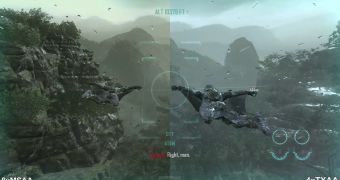While Call of Duty games haven’t exactly set the benchmark for visual experiences in the last few years, as they’re still based on the old IW 3.0 engine, albeit with incremental improvements through each iteration, the latest game in the series – Black Ops 2 – brings quite a few new features on the PC platform, including support for DirectX 11 or new types of anti-aliasing.
Seeing as how Nvidia is backing the TXAA technology with its new Kepler-based graphics cards, we decided to see if it can actually deliver a better experience than more conventional anti-aliasing systems, like MSAA.
As such, we armed ourselves with an Nvidia GTX 680 graphics card, the latest beta drivers that deliver an improved performance in Call of Duty: Black Ops 2, and ran through the opening segments of the game’s second level – Celerium – using both the 8xMSAA and the 4xTXAA setting.
As you can see in the video above, which directly compares the two anti-aliasing technologies at first and then alternates between them, there are some differences.
The first one is that the TXAA footage has a more bluish hue than the MSAA one, which retains a color palette closer to brown than blue.
What’s more, during the wingsuit flight sequence, you notice an overall sharper tone for the TXAA playthrough as the MSAA one features a bit more blurriness and a lot more fog that masks the foliage and trees.
Another smaller difference noticed by us is that the uniforms of your squadmates are a bit shinier when running on TXAA than MSAA.
Overall, while you can spot quite a few differences while running on TXAA, we didn’t experience any noticeable differences in quality or framerate, although the TXAA playthrough felt a bit smoother than the MSAA one.
Judge for yourselves by enjoying our video comparison above.

 14 DAY TRIAL //
14 DAY TRIAL //